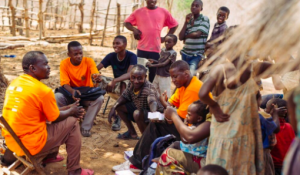Much is written about the transformative effect the cloud can have on businesses, but I am inspired by a project that is helping a non-profit organisation in its effort to help eradicate disease and ultimately save lives.
Today, the cloud offers access to on-demand computing resources that, only a few years ago, would have been considered super-computing. The “Visualise No Malaria” project led by business intelligence software vendor Tableau and the non-profit organisation PATH is using cloud-powered real-time analytics to help the Zambia government eradicate malaria from its country by 2020.
Making an impact on people’s lives
PATH is a global non-profit organisation that aims to save lives and improve the health of vulnerable people in need through the application of technology. The organisation has an innovative approach to tackling health issues, with its strategic application of vaccines, drugs, diagnostics, devices, and system and service innovations for maximum impact.
[easy-tweet tweet=”PATH-pioneered approaches have contributed to saving 6.2 million lives over the course of 15 years” hashtags=”PATH, Cloud “]
PATH-pioneered approaches have contributed to saving 6.2 million lives over the course of 15 years, but its malaria programme doesn’t just want to control malaria. PATH has set out to assist the Zambian government in its quest to eliminate malaria in Zambia within three years. For the Visualise No Malaria project, PATH enlisted the help of Tableau to apply its considerable experience in data analytics to understanding the cause and probability of malaria outbreaks in populated areas across Zambia’s vast 750,000 km² landscape – a country three times the size of the UK.
Visualise No Malaria
The Visualize No Malaria team built upon Tableau’s tools by engaging partners such as Alteryx, EXASOL and Twilio to build a complete technology “stack” in the cloud for real-time operational intelligence.
PATH has enlisted the help of “Tableau Zen Masters” – experts nominated by the Tableau community for their desire to help improve Tableau solutions. These experts have volunteered to help by sharing their skills and knowledge with health workers in Zambia on the frontline. They are helping to automate workflows and improve the visualisations so that Zambian officials have the intelligence that they need to predict which area of Zambia will next be affected by an outbreak.
[easy-tweet tweet=”By integrating mapping technologies…health workers can predict areas where mosquitoes breed” hashtags=”Mappingtechnology, Cloud”]
By integrating mapping technologies and testing algorithms, the Zen Masters have been able to help Zambian health officials understand how to map geospatial data such as elevation and slope and combine it with hydrological features, such as topographic wetness and stream power. In doing so, health workers can now create a very precise, accurate map of water courses, and so are able to predict likely areas where mosquitoes will breed. By combining this information with meteorological models of precipitation and temperature, a relationship can be established that allows Zambian health officials to proactively focus energy and resources areas where malaria outbreaks are most likely to occur.
The power is in the cloud
It is the cloud that makes this all possible. The data is aggregated in EXASOL’s analytic database running on Amazon Web Services, which is specifically designed to analyse large datasets very quickly through the optimal use of server memory. This computing power makes it possible for the PATH team to analyse massive data sets at very high speed and produce near on-demand intelligence using Tableau and Alteryx and take action against the malaria-ridden parasite where the probability of an outbreak is highest.
Cloud elasticity has an important role to play in enabling the project’s future. The scalability of EC2 instances and storage means that as the data sets used to continue to grow, the ability to run fast analytic queries will not be hampered because the analytic and visualisation solution has been built to scale. This is crucial, as the quality and accuracy of the visualisations will improve as more data is collected and analysed.
 Speeding ahead
Speeding ahead
PATH has empowered the Zambian government to tackle malaria head-on, and the Visualise No Malaria project has provided the tools and know-how to tackle this health imperative. Through the work of Tableau, EXASOL, Alteryx, and the other technology partners of the Visualise No Malaria project, Zambian officials now have the confidence to use the data they have at their fingers tips, which will allow them to make informed decisions and devise new strategies to stop the disease from spreading.
In Africa, a child dies every two minutes from malaria. It is a preventable and curable disease so with better intelligence provided by improved analytics, resources can be directed appropriately in a way that saves the most lives. It is a humbling display of what data can do in the right hands when combined with the best tools for the job. We hope that as this project proves itself, the benefits it brings will be leveraged by other nations in sub-Saharan Africa and beyond to help eliminate malaria.
Aaron Auld is CEO of EXASOL and is in charge of coordinating the EXASOL’s strategic direction and positioning as well as its international expansion.
He has a law degree from Munich University and an M.B.L. in international business law from the University of St. Gallen in Switzerland where he finished top of his year. He has served as General Counsel for Ocè’s global software business (acquired by Canon) and managed the legal execution of primion¹s IPO on the Frankfurt Stock Exchange as well as several merger and acquisition deals before joining EXASOL in 2006. At EXASOL, Aaron was previously responsible for Operations before becoming CEO in 2013. He is Scottish by upbringing but has embraced German virtues where he lives and works today.


 Speeding ahead
Speeding ahead